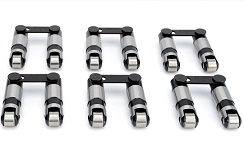An SBC Cam Kit or another camshaft and lifter can improve engine performance, which is especially important for drag racers and racing enthusiasts. The kits are critical in controlling intake and exhaust valves in internal combustion engines.
Unfortunately, the installation for the kits can vary, depending on the engine make and model. Still, it is possible to understand general installation requirements and methods.
Understanding Camshafts and Lifters
A camshaft is a lengthy, rotating metal bar with several lobes along its length. The lobes indicate the timing of specific valves as they open and close. Ultimately, camshafts can influence things like horsepower, torque, and idle characteristics.
Lifters appear along the camshaft between lobes and valve stems. The devices translate rotational movement into vertical movement, pushing valves open or closed. You can select different lifters depending on your needs. The three main types include flat tappets, hydraulic, and rollers.
Installing Camshaft and Lifter Kits
If you want to improve racing performance, you’ll need more than drag tires. Camshaft and lifter kits can improve performance and power off the line, but installing them is no small feat. The installation process includes three main steps: preparation, installation, and breaking-in.
Preparation
First, you must consult your vehicle’s engine manual. The manual typically provides specific instructions about parts and installation requirements. It is usually more accurate than other information you might find,
Second, take the time to gather any necessary tools. Some tools you might want nearby include engine stands, socket wrenches, torque wrenches, camshaft timing tools, and a harmonic balancer puller.
Third, disconnect your vehicle’s battery. While installing the kit without this step is possible, the step is precautionary to avoid electrical shorts.
Finally, drain the engine coolant and oil. Draining the engine makes it easier to remove all necessary parts.
Installation
Whether working with an Edelbrock 1913 or some other equipped engine, the general installation process follows a similar set of steps. First, remove the timing chain and belt to gain access to the camshaft. Second, remove the camshaft sprockets and carefully slide out the old camshaft.
Third, install the new camshaft and camshaft sprockets. Fourth, install the new timing chain or belt, aligning timing marks correctly. Fifth, install the new lifters and pushrods.
Finally, reinstall any covers and refill the engine oil and coolant. Then, reconnect the battery.
Breaking-In
To break in the new camshaft and lifters, start your engine and let the vehicle idle for 30 minutes. After idling, change the oil and oil filter to remove any metal shavings that may have been produced during the break-in period.
Camshaft and lifter kits are excellent options for increasing the power and performance of your engine. Still, the installation process is not as straightforward as it sounds. If you are an amateur or novice, it is best to contact a qualified mechanic to schedule the installation of the kit. That said, if you are an experienced hobbyist or professional, consult your local auto parts store to find the correct kit for your vehicle.
